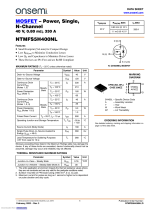
SiHP25N50E
www.vishay.com Vishay Siliconix
S22-0948-Rev. E, 21-Nov-2022 2Document Number: 91626
For technical questions, contact: hvm@vishay.com
THIS DOCUMENT IS SUBJECT TO CHANGE WITHOUT NOTICE. THE PRODUCTS DESCRIBED HEREIN AND THIS DOCUMENT
ARE SUBJECT TO SPECIFIC DISCLAIMERS, SET FORTH AT www.vishay.com/doc?91000
Notes
a. Coss(er) is a fixed capacitance that gives the same energy as Coss while VDS is rising from 0 % to 80 % VDSS
b. Coss(tr) is a fixed capacitance that gives the same charging time as Coss while VDS is rising from 0 % to 80 % VDSS
THERMAL RESISTANCE RATINGS
PARAMETER SYMBOL TYP. MAX. UNIT
Maximum junction-to-ambient RthJA -62
°C/W
Maximum junction-to-case (drain) RthJC -0.5
SPECIFICATIONS (TJ = 25 °C, unless otherwise noted)
PARAMETER SYMBOL TEST CONDITIONS MIN. TYP. MAX. UNIT
Static
Drain-source breakdown voltage VDS VGS = 0 V, ID = 250 μA 500 - - V
VDS temperature coefficient VDS/TJ Reference to 25 °C, ID = 1 mA - 0.59 - V/°C
Gate-source threshold Voltage (N) VGS(th) VDS = VGS, ID = 250 μA 2.0 - 4.0 V
Gate-source leakage IGSS VGS = ± 20 V - - ± 100 nA
VGS = ± 30 V - - ± 1 μA
Zero gate voltage drain current IDSS
VDS = 500 V, VGS = 0 V - - 1 μA
VDS = 400 V, VGS = 0 V, TJ = 125 °C - - 25
Drain-source on-state resistance RDS(on) V
GS = 10 V ID = 12 A - 0.125 0.145
Forward transconductance gfs VDS = 30 V, ID = 12 A - 6.6 - S
Dynamic
Input capacitance Ciss VGS = 0 V,
VDS = 100 V,
f = 1 MHz
- 1980 -
pF
Output capacitance Coss - 105 -
Reverse transfer capacitance Crss -8-
Effective output capacitance, energy
related a Co(er)
VDS = 0 V to 400 V, VGS = 0 V
- 105 -
Effective output capacitance, time
related b Co(tr) - 285 -
Total gate charge Qg
VGS = 10 V ID = 12 A, VDS = 400 V
-5786
nC Gate-source charge Qgs -14-
Gate-drain charge Qgd -25-
Turn-on delay time td(on)
VDD = 400 V, ID = 12 A
Rg = 9.1 , VGS = 10 V
-1938
ns
Rise time tr -3672
Turn-off delay time td(off) -5786
Fall time tf -2958
Gate input resistance Rg f = 1 MHz, open drain - 0.56 -
Drain-Source Body Diode Characteristics
Continuous source-drain diode current ISMOSFET symbol
showing the
integral reverse
p - n junction diode
--12
A
Pulsed diode forward current ISM --50
Diode forward voltage VSD TJ = 25 °C, IS = 16.5 A, VGS = 0 V - - 1.2 V
Reverse recovery time trr TJ = 25 °C, IF = IS,
dI/dt = 100 A/μs, VR = 25 V
- 338 - ns
Reverse recovery charge Qrr -5.3-μC
Reverse recovery current IRRM -29-A
Downloaded from Arrow.com.Downloaded from Arrow.com.









